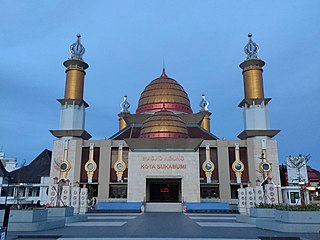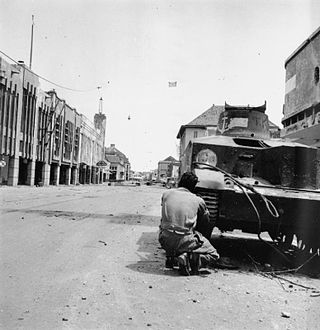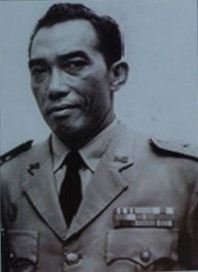
Sukabumi is a landlocked city surrounded by the regency of the same name in the southern foothills of Mount Gede, in West Java, Indonesia, about 100 km (62 mi) south of the national capital, Jakarta.

Sukabumi Regency is a regency (kabupaten) in southwestern Java, as part of West Java province of Indonesia. The regency seat is located in Palabuhan Ratu, a coastal district facing the Indian Ocean. The regency fully encircles the administratively separated city of Sukabumi. Covering an area of 4,164.15 km2, the regency is the largest regency in West Java and the second largest regency on Java after the Banyuwangi Regency in East Java. The regency had a population of 2,341,409 at the 2010 census and 2,725,450 at the 2020 census; the official estimate as at mid 2023 was 2,802,404, with a large proportion of it living in the northeastern part of the regency that encircles Sukabumi City, south of Mount Gede. A plan to create a new regency, the putative North Sukabumi Regency, was considered by the Indonesian government in 2013, but has been deferred until the end of the current morotorium on new creations of regencies.

The Battle of Surabaya was a major battle in the Indonesian National Revolution fought between regular infantry and militia of the Indonesian nationalist movement and British and British Indian troops against the re-imposition of Dutch colonial rule. The peak of the battle was in November 1945. The battle was the largest single battle of the revolution and became a national symbol of Indonesian resistance. Considered a heroic effort by Indonesians, the battle helped galvanise Indonesian and international support for Indonesian independence. 10 November is celebrated annually as Heroes' Day.

Padalarang Station is a railway station complex in Padalarang, West Bandung Regency, West Java, Indonesia. The complex is planned to serve long-distance train services from Kereta Api Indonesia, commuter trains from KAI Commuter, and Jakarta-Bandung high-speed trains from Kereta Cepat Indonesia China (KCIC). The complex is in the form of two different station buildings, each operated by KAI and KCIC, and connected via a pedestrian bridge.

In Dutch historiography, Bersiap refers to the violent and chaotic beginning of the Indonesian National Revolution following the end of World War II in Asia. In Indonesia, the term Berdaulat ("Sovereign") is also used for this transitional period. It began after Sukarno's proclamation of Indonesian Independence on 17 August 1945 and culminated during the power vacuum between the withdrawal of Japanese occupational forces and the gradual buildup of a British military presence, before the official handover to a Dutch military presence in March 1946.
Indonesian National Route 2 connects Jakarta and Cibadak, Sukabumi. It runs from north to south. It passes two provinces, namely Jakarta and West Java.

I Gusti Ketut Pudja was an Indonesian politician and national hero, who served as the first governor of Lesser Sunda from 1945 until 1946. He was a member of the Investigating Agency for Preparatory Work for Indonesian Independence (BPUPK). He was also present at Admiral Tadashi Maeda's house, during the preparation for the Proclamation of Indonesian Independence on 17 August 1945. Making him the only Balinese to be present during the proclamation.

The Battle of Medan, known locally as the Battle for the Medan Area took place between Allied forces and the Indonesian Army in Medan, North Sumatra, and its surrounding area during the Indonesian National Revolution.
Bojong Kokosan Museum is a museum that was built as the appreciation for the Indonesian fighters against the British army and Civil Administration]] (NICA) during Netherlands colonialisation. The battle occurred in December 1945 to 1946. Bojong Kokosan Museum is located in Jalan Siliwangi number 75 in Sukabumi Regency, West Java, Indonesia.

The Semarang offensive is composite of the Battle of Ambarawa, Magelang offensive, Battle of Ungaran or Ungaran offensive, and Semarang offensive proper. This major battle took place between the recently created Indonesian Army and the British Army with the Dutch forces that occurred between 20 October 1945 and 2 March 1946 in Semarang city, Semarang Regency, and Magelang Regency in Central Java, Indonesia. Perhaps the most successful Indonesian offensive of the Indonesian Revolution, this offensive tightened British and Dutch control from the Magelang and Semarang metropolitan areas to only Semarang city. In modern times, 15 December is celebrated as the Indonesian National Infantry Day.
The Battle of Margarana was fought between the Netherlands Indies Civil Administration (NICA) and the recently created, rebelling Ciung Wanara Battalion that occurred in Marga, in Bali Indonesia.

The Battle of Semarang, in Indonesia also known as Pertempuran Lima Hari was a clash between Japanese forces of the Sixteenth Army and Indonesian forces consisting of People's Security Agency personnel and pemuda in October 1945 at the city of Semarang, Central Java. The battle is considered as the first major clash involving the Indonesian military.

The Battle of Kotabaru was a clash between Indonesian nationalists and a Japanese garrison in Yogyakarta on 7 October 1945. The Indonesians launched an attack on the Japanese garrison with the intent of acquiring weapons for use in the war of independence.

Cianjur Station (CJ) is a class II railway station located in Sayang, Cianjur, Cianjur Regency, West Java, Indonesia. The station, which is located at an altitude of 439 m, is included in the Operation Area II Bandung. This station is the station with the highest passenger density on the Cianjur–Padalarang route.
Battle of Kumai or also known locally as Battle of 14 January was a clash between Netherlands Indies Civil Administration and Royal Netherlands East Indies Army against Indonesian militias in town of Kumai, Central Kalimantan. Indonesian militias, consisted of mostly pemuda (youths), newly formed Indonesian Army, and armed Islamic cleric militia; known as Barisan Ulama or Barisan Berjenggot, confronted Dutch armed convoys that tried to land in the port.

Lieutenant General Djamin Ginting, was an Indonesian military officer and independence fighter from Tanah Karo. He was appointed a National Hero of Indonesia by President Joko Widodo on 7 November 2014.
The bombing of Sukabumi was an aerial bombing of the city of Sukabumi, West Java in the Dutch East Indies during the Dutch East Indies campaign of World War II. On the morning of Friday, 6 March 1942, a formation of seven Imperial Japanese aircraft indiscriminately bombed and strafed government buildings, infrastructure, and residential areas, resulting in the deaths of around 70 people and destruction throughout the city.
Edi Sukardi was an Indonesian lieutenant-colonel who is recorded as a leader in the Battle of Bojong Kokosan which occurred at Sukabumi, 9 December 1945. The Battle of Bojong Kokosan was later commemorated as Juang Siliwangi Day. In the Battle of Bojong Kokosan, the People's Security Army/Tentara Keamanan Rakyat (PSA/TKR) and various spectra of people's warriors, both left and right, intercepted the British army. A total of 73 TKR members were killed, as well as more than 80 British soldiers killed.

The Battle of Padang Area was a fierce engagement between Indonesian forces and Allied troops in Padang, West Sumatra. The conflict began when Allied forces initiated clashes and looted several Indonesian headquarters in the city. In response, Indonesian forces launched counterattacks in Padang, leading to a series of skirmishes throughout the area.













